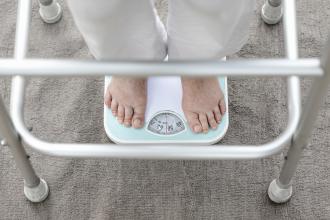Obesity: A risk factor for severe infection with coronavirus SARS-CoV-2
The COVID-19 pandemic is of particular relevance to patients with obesity. Early clinical reports from China, Italy, and the US identified that age, hypertension, cardiac disease, and diabetes are strongly associated with severe disease and death from infection with SARS-CoV-2.[1-5] Obesity was demonstrated to be an important risk factor for severe infection from the influenza A H1N1 virus,[6] and emerging evidence suggests that this is also the case for SARS-CoV2.
Recent studies from China, France, and the US show that COVID-19 positive patients with a higher body mass index (BMI) have greater odds of experiencing disease requiring acute or critical care, and may be less likely to survive.[7-9]
The largest study to date, evaluating the association of BMI with SARS-CoV-2 infection was a retrospective analysis of 3615 COVID-19 positive symptomatic patients in a New York academic hospital.[7] Among patients younger than 60 years, persons with a BMI between 30 and 34 kg/m2 were 2 times more likely to be admitted to acute care and critical care. Similarly, patients younger than 60 years with a BMI ≥ 35 kg/m2, were 4 times more likely to be admitted to critical care. This study adjusted for age but not comorbid conditions.
There are several biologically plausible mechanisms for the association between obesity and more serious infection from SARS-CoV-2. Obesity is a state of chronic inflammation with high concentrations of pro-inflammatory cytokines, which causes reduced macrophage activation and blunted cytokine production contributing to impaired innate immunity.[10] Leptin is a hormone made by fat cells and is a marker of the degree of adiposity. Leptin levels are high in patients with obesity and it has been shown to interfere with the body’s ability to mount an effective immune response to vaccination or infection. It is possibly the basis of the poor vaccination success rates in patients with obesity as well as their increased susceptibility to viral infections.[11]
Persons with obesity shed influenza A virus for longer periods, increasing the chance of spread.[12] This is important in determining self-isolation times. Furthermore, BMI correlates positively with the concentration of infectious virus in exhaled breath and evidence suggests that the obesity microenvironment contributes to greater disease virulence.[13,14]
Mounting evidence supports obesity as a risk factor for severe COVID-19 disease. Isolation of positive cases and physical distancing are currently the primary interventions. Persons with obesity should be especially careful to avoid infection. Physicians should also be aware of the psychological toll associated with obesity and the need to support our patients’ physical and mental well-being amid the global pandemic.
—Priya Manjoo, MD
—Katie Bowers, MPP
hidden
This article is the opinion of the Nutrition Committee, a subcommittee of Doctors of BC’s Council on Health Promotion, and is not necessarily the opinion of Doctors of BC. This article has not been peer reviewed by the BCMJ Editorial Board.
References
1. Onder G, Rezza G, Brusaferro S. Case-fatality rate and characteristics of patients dying in relation to COVID-19 in Italy. JAMA 2020. doi:10.1001/jama.2020.4683.
2. Zhou F, Yu T, Du R, et al. Clinical course and risk factors for mortality of adult inpatients with COVID-19 in Wuhan, China: A retrospective cohort study. Lancet 2020:395(10229):1054-1062.
3. Guan WJ, Ni Z-Y, Hu Y, et al. Clinical characteristics of coronavirus disease 2019 in China. N Engl J Med 2020. doi:10.1056/NEJMoa2002032.
4. Grasselli G, Pesenti A, Cecconi M. Critical care utilization for the COVID-19 outbreak in Lombardy, Italy: Early experience and forecast during an emergency response. JAMA 2020. doi:10.1001/jama.2020.4031.
5. Arentz M, Yim E, Klaff L, et al. Characteristics and outcomes of 21 critically ill patients with COVID-19 in Washington State. JAMA 2020. doi:10.1001/jama.2020.4326.
6. Morgan OW, Bramley A, Fowlkes A, et al. Morbid obesity as a risk factor for hospitalization and death due to 2009 pandemic influenza A(H1N1) disease. PLoS One 2010;5:e9694.
7. Peng YD, Meng K, Guan HQ, et al. [Clinical characteristics and outcomes of 112 cardiovascular disease patients infected by 2019-nCoV]. 2020;48:E004.
8. Lighter J, Phillips M, Hochman S, et al. Obesity in patients younger than 60 years is a risk factor for Covid-19 hospital admission. Clin Infect Dis 2020. doi:10.1093/cid/ciaa415.
9. Simonnet A, Chetboun M, Poissy J, et al. High prevalence of obesity in severe acute respiratory syndrome coronavirus-2 (SARS-CoV-2) requiring invasive mechanical ventilation. Obesity (Silver Spring) 2020. doi:10.1002/oby.22831.
10. Bahr I, Spielmann J, Quandt D, Kielstein H. Obesity-associated alterations of natural killer cells and immunosurveillance of cancer. Front Immunol 2020;11:245.
11. Painter SD, Ovsyannikova IG, Poland GA. The weight of obesity on the human immune response to vaccination. Vaccine 2015;33:4422-4429.
12. Maier HE, Lopez R, Sanchez N, et al. Obesity increases the duration of influenza A virus shedding in adults. J Infect Dis 2018;218:1378-1382.
13. Honce R, Karlsson EA, Wohlgemuth N, et al. Obesity-related microenvironment promotes emergence of virulent influenza virus strains. mBio 2020;11:e03341-19.
14. Yan J, Grantham M, Pantelic J, et al. Infectious virus in exhaled breath of symptomatic seasonal influenza cases from a college community. Proc Natl Acad Sci U S A 2018;115:1081-1086.

